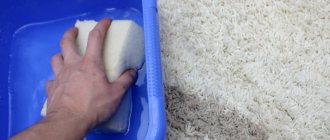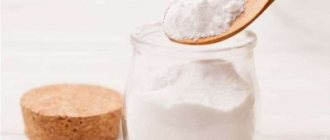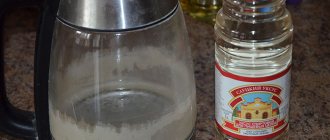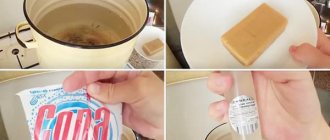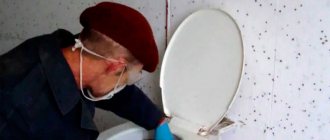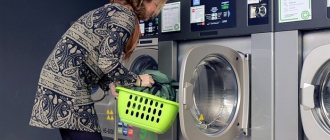Blockages in pipes cause a lot of inconvenience, causing stagnation of water and an unpleasant odor. Advertising means are not always effective, so we have to look for alternative solutions to the problem. Experienced housewives use proven recipes that contain soda and vinegar to clean pipes. When the solution is prepared correctly, they help remove the blockage for a long time. Read about how the products work and the cleaning processes in this article.
ATTENTION! A unique, highly effective product has been developed for cleaning sewer pipes, eliminating any blockages. The product is a concentrated mixture of enzymes that easily break down and process fat accumulations and any deposits of organic origin. One package of Saniclean will last you a whole year! Read more"
How to wash off grease with vinegar and soda
Most modern products against grease and carbon deposits are highly toxic and have a very undemocratic price. Therefore, many housewives prefer to get rid of dirt with baking soda, using products that are easily prepared at home.
If you need to clean grease from kitchen appliances:
- Apply undiluted 9% vinegar to the surface.
- Sprinkle a thin layer of baking soda on the damp areas.
- Leave the product for 2-3 hours.
The reaction that occurs during the interaction of soda with vinegar will easily remove even a thick fat layer. The product is removed with a sponge; after removal, the oven must be rinsed.
We discussed in detail how to wash a frying pan with soda in the previous article.
To clean the oven glass, use baking soda powder diluted with water to a liquid paste. Apply the mixture to the glass using a soft cloth, leave for 30 minutes, then rinse.
To clean a glass-ceramic hob, use this recipe:
- Dissolve 25 g in a small amount of hot water. laundry soap. Add 20 g to the solution. baking soda and 2 tbsp. vinegar essence.
- Apply gently onto the stove and leave for two hours. When applying, do not rub the surface of the stove - this will damage the glass-ceramic coating.
You can clean your bathtub using baking soda and vinegar; read about this below.
Preventive measures
To avoid problems, plumbers recommend regularly taking preventative measures. Such actions will help extend the service life of plumbing fixtures and will prevent food residues and grease from accumulating in the pipe openings. It is advisable to carry out cleaning activities at least once a month, this will prevent the accumulation of grease in the water supply. It is recommended to periodically open the hot water tap.
To prevent the formation of traffic jams, special devices are installed - grease traps. They are periodically removed and washed. Do not throw care products, garbage, or hair into the sink, bathtub or toilet. It is not advisable to wash dirty shoes from the street in the bath.
Often the cause of blockages is a worn-out pipeline. It is necessary to promptly replace failed parts during operation.
Wash the hood grate with soda
In addition to the stoves, there is another element in the kitchen that constantly needs cleaning - the grille on the hood. The most popular cleaning method:
- Dilute 50-70 gr. soda powder with warm water to a paste. Apply the mixture to the grate.
- Leave for an hour, if heavily soiled - for 1.5-2 hours. Wipe the grill with a medium-hard sponge, and then rinse thoroughly under running water.
This method is also suitable for grates on a gas stove.
Lemon acid
It is gentle on the surface of the stove, but harmful to fat.
Acid breaks down plaque and also has a good abrasive effect, which additionally removes dirt.
Necessary:
- Moisten the stain with a damp sponge.
- Apply a tablespoon of citric acid granules.
- Let stand for 3-5 minutes, then walk over the surface with the hard side of the sponge.
To increase abrasiveness, citric acid can be mixed with coarse table salt and the manipulation can be repeated.
Advantages:
- A safe method that does not cause irritation upon contact with exposed skin.
- Removes old stains well.
- Makes the surface glossy.
- Gives a pleasant lemon aroma.
Flaws:
- Not suitable for daily cleaning as it contains a high level of acidity.
Expert opinion
Borodina Galina Valerievna
If there is a lemon left in the refrigerator that will no longer be used for food, you can cut it into pieces and walk over the dirty surfaces of the stove. Light stains will quickly disappear even without a sponge, and the hob will get a shine.
How to completely remove grease from a hood with soda
Before you start cleaning the hood:
- De-energize the exhaust device. Remove the grille and mesh of the hood.
- Remove and clean the pipe leading to the air duct.
- Check if the hood filter can be cleaned - not all types of filters can be cleaned with baking soda powder. Typically, this information is contained in the instruction manual.
To clean the hood from grease with soda:
- Pour water into a large saucepan. Add 30-40 gr. finely grated laundry soap, add 2 tbsp. sodium bicarbonate.
- Stir and dip all parts that need to be cleaned into the cleaning solution. Place the pan on the stove, let it boil and simmer for 20 minutes.
- Then leave to cool for 20-30 minutes, rinse under running water.
Cleaning surfaces
Compound:
- Orange (lemon) peel;
- Vinegar.
Preparation:
- Cut the peel, pour into a jar;
- Pour in vinegar and leave for 10 days;
- Keep the container in a cool, dark place.
The resulting product can clean any surface. You just need to be careful with a tree that can fade.
Baking soda and sunflower oil will get rid of fat
In addition to stoves and hoods, “kitchen” dirt also accumulates on furniture. To degrease with soda, you will need a soda-oil mixture, which can effectively remove greasy deposits without damaging the surface of the kitchen furniture.
- Stir 50 gr. soda with 2-3 teaspoons of sunflower oil. Add the oil gradually - you should get a mixture with a consistency reminiscent of thick sour cream.
- Using a soft sponge, apply the mixture in a circular motion to the contaminated surfaces. After finishing cleaning, wipe the doors and other surfaces with a clean damp cloth.
In the next article we will look at how to clean silver with soda.
Steam cleaning method
You can use another effective method to clean your oven. This is to arrange a “water bath”. Steam helps soften plaque. This makes it much easier to remove dirt. But ordinary water will not be able to cope with this task. The ingredient to be used in the “water bath” may be vinegar. How to clean the oven with vinegar, or rather vinegar essence - you must follow the following steps:
- Turn on the oven and set the temperature to 200 °C.
- Take a deep baking tray for convenience. Pour 1 liter of water into it. Add 2 teaspoons of essence.
- Place a baking sheet with the prepared solution in a preheated oven.
- As soon as the liquid boils (after 15-20 minutes, when the door starts to fog up), you need to turn off the oven.
After the stove has completely cooled down, open the door and wipe with a damp sponge and then with a dry towel.
Soda for grease in the dishwasher
There are several ways to use baking soda in dishwashers:
- Sodium bicarbonate and acetic acid. To clean your machine of old dirt, place 1/2 cup of 9% vinegar in one of the dishwasher baskets and run the machine on a long cycle. Then pour in half a cup of baking soda and run the dishwasher again for a short cycle.
- Take 1 tbsp. soda powder, mix it with 10 drops of any essential oil and add 1.5 tbsp to the mixture. hydrogen peroxide. Mix thoroughly and pour into the machine. Place 1/2 cup of 9% vinegar in the upper basket and turn on the wash program.
- Powdered soda works well for washing dishes in the dishwasher. Take washing powder for baby clothes that does not contain phosphates and fragrances, mix it in equal proportions with soda powder. For one cycle, 25 grams will be enough for you. facilities.
After using baking soda as a detergent, do not forget to use dishwasher rinse aid.
Instead of powder, you can also use special homemade tablets, which are a good alternative to store-bought products. To prepare them you will need:
- Mix 250 gr. dry magnesia (sodium sulfate), 75 gr. regular baking soda and 100 gr. Boers. Mix all the ingredients thoroughly and then add 10-15 drops of lemon juice to them.
- When the reaction with a slight hiss passes, place the finished product in small molds. After complete drying, the tablets are ready.
- They should be used in the same way as regular dishwasher tablets. To enhance the effect, you can combine homemade tablets with car salt.
Washing the dishes
An eco-friendly lifestyle is not just a fashion statement, but a concern for your health. You can replace synthetic dishwashing detergent with a safer analogue. A damp sponge dipped in soda effectively removes soot, soot, tea stains and yellowness. If unattractive stains remain on your crystal glasses after washing, rinse them in water with vinegar added. This method will make the dishes sparkle and destroy pathogens.
Features of cleaning pans made of different materials
Frying pans come in cast iron, steel and aluminum with or without non-stick coating. For each material there are recommendations on how to properly clean it.
Features of cleaning various pans:
| Material/type of pan coating | Features of carbon deposits cleaning | Contraindications |
| Teflon (Tefal) | You can clean tefal pans with neutral or alkaline dish gels. | Does not tolerate overheating, sudden cooling, abrasives |
| Cast iron without coating | Abrasive products will clean well | Acids cause rust |
| Coated cast iron (grill cookware and pancake pan) | Carbon deposits are washed off with fat-dissolving chemicals | A cast iron frying pan cannot be cleaned with metal utensils. |
| Ceramic | It is better to clean household chemicals with a neutral pH and solutions with alcohol or hydrochloric acid | Do not sharply cool or tap. Products with acid, chlorine, alkali are contraindicated |
| Titanium | The coating is scratch resistant. You can clean a non-stick frying pan with any household dishwashing chemical. | It is not recommended to remove carbon deposits with dry soda, sand, or other abrasives. |
| Steel without coating | The carbon deposits will be cleaned with a gel, a product with glue, vinegar, lemon, ammonia, soda, mustard | Contaminants cannot be removed with chlorides and acidic chemicals |
| Aluminum and duralumin without coating | It is better to clean with neutral products without abrasive particles. | An aluminum frying pan cannot be treated with acid-containing chemicals or metal utensils. |
| Marble or granite | It is better to clean carbon deposits using products in the form of foam, solution, cream, paste | It is forbidden to cool a stone frying pan sharply or wash it with powder or abrasive sponges. |
| Pancake maker with non-stick coating | A solution with a neutral pH will clean the pancake pan. | Use products designed to care for this material. |
Carbon deposits from pans made of aluminum, duralumin and on the non-stick side must not be removed with metal products. It is better to clean it with synthetic tools and non-abrasive products after it has cooled at room temperature.
